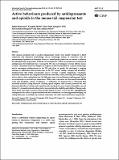Por favor, use este identificador para citar o enlazar a este item:
http://hdl.handle.net/10261/66318COMPARTIR / EXPORTAR:
 SHARE SHARE
 CORE
BASE CORE
BASE
|
|
| Visualizar otros formatos: MARC | Dublin Core | RDF | ORE | MODS | METS | DIDL | DATACITE | |

| Campo DC | Valor | Lengua/Idioma |
|---|---|---|
| dc.contributor.author | Berrocoso, E. | - |
| dc.contributor.author | Ikeda, K. | - |
| dc.contributor.author | Sora, Ichiro | - |
| dc.contributor.author | Uhl, G. R. | - |
| dc.contributor.author | Sánchez-Blázquez, Pilar | - |
| dc.contributor.author | Mico, J. A. | - |
| dc.contributor.author | Sánchez-Blázquez, Pilar | - |
| dc.date.accessioned | 2013-02-07T13:06:01Z | - |
| dc.date.available | 2013-02-07T13:06:01Z | - |
| dc.date.issued | 2013 | - |
| dc.identifier | doi: 10.1017/S1461145711001842 | - |
| dc.identifier | issn: 1461-1457 | - |
| dc.identifier.citation | International Journal of Neuropsychopharmacology 16: 151-162 (2013) | - |
| dc.identifier.uri | http://hdl.handle.net/10261/66318 | - |
| dc.description.abstract | Most classical preclinical tests to predict antidepressant activity were initially developed to detect compounds that influenced noradrenergic and/or serotonergic activity, in accordance with the monoaminergic hypothesis of depression. However, central opioid systems are also known to influence the pathophysiology of depression. While the tail suspension test (TST) is very sensitive to several types of antidepressant, the traditional form of scoring the TST does not distinguish between different modes of action. The present study was designed to compare the behavioural effects of classical noradrenergic and/or serotonergic antidepressants in the TST with those of opioids. We developed a sampling technique to differentiate between behaviours in the TST, namely, curling, swinging and immobility. Antidepressants that inhibit noradrenaline and/or serotonin re-uptake (imipramine, venlafaxine, duloxetine, desipramine and citalopram) decreased the immobility of mice, increasing their swinging but with no effect on their curling behaviour. No differences were observed between antidepressants that act on noradrenergic or serotoninergic transmission. While opioid compounds also decreased the immobility of the mice [morphine, codeine, levorphanol, (-)-methadone, (±)-tramadol and (+)-tramadol], they selectively increased curling behaviour. Blocking opioid receptors with naloxone prevented the antidepressant-like effect of codeine, and ο-opioid receptor knockout decreased normal curling behaviour and blocked (±)-tramadol-induced curling, further demonstrating the reliability and validity of this approach. These results show that at least two behaviourally distinct processes occur in the TST, highlighting the antidepressant-like effects of opioids evident in this test. Furthermore, our data suggest that swinging and curling behaviours are mediated by enhanced monoamine and opioid neurotransmission, respectively. © 2011 CINP. | - |
| dc.language.iso | eng | - |
| dc.publisher | Cambridge University Press | - |
| dc.rights | openAccess | - |
| dc.title | Active behaviours produced by antidepressants and opioids in the mouse tail suspension test | - |
| dc.type | artículo | - |
| dc.identifier.doi | 10.1017/S1461145711001842 | - |
| dc.date.updated | 2013-02-07T13:06:01Z | - |
| dc.description.version | Peer Reviewed | - |
| dc.identifier.pmid | 22217458 | - |
| dc.type.coar | http://purl.org/coar/resource_type/c_6501 | es_ES |
| item.openairecristype | http://purl.org/coar/resource_type/c_18cf | - |
| item.fulltext | With Fulltext | - |
| item.cerifentitytype | Publications | - |
| item.openairetype | artículo | - |
| item.languageiso639-1 | en | - |
| item.grantfulltext | open | - |
| Aparece en las colecciones: | (IC) Artículos | |
Ficheros en este ítem:
| Fichero | Descripción | Tamaño | Formato | |
|---|---|---|---|---|
| Sanchez-Blazquez,2013,InternatJNeuropsychopharmacol.pdf | 232,28 kB | Adobe PDF |  Visualizar/Abrir |
CORE Recommender
PubMed Central
Citations
39
checked on 31-mar-2024
SCOPUSTM
Citations
68
checked on 13-abr-2024
WEB OF SCIENCETM
Citations
59
checked on 29-feb-2024
Page view(s)
497
checked on 18-abr-2024
Download(s)
401
checked on 18-abr-2024
Google ScholarTM
Check
Altmetric
Altmetric
Artículos relacionados:
NOTA: Los ítems de Digital.CSIC están protegidos por copyright, con todos los derechos reservados, a menos que se indique lo contrario.
